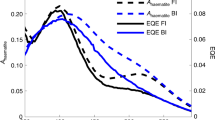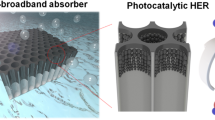Abstract
Semiconductor photoelectrodes for solar hydrogen production by water photoelectrolysis must employ stable, non-toxic, abundant and inexpensive visible-light absorbers. Iron oxide (α-Fe2O3) is one of few materials meeting these requirements, but its poor transport properties present challenges for efficient charge-carrier generation, separation, collection and injection. Here we show that these challenges can be addressed by means of resonant light trapping in ultrathin films designed as optical cavities. Interference between forward- and backward-propagating waves enhances the light absorption in quarter-wave or, in some cases, deeper subwavelength films, amplifying the intensity close to the surface wherein photogenerated minority charge carriers (holes) can reach the surface and oxidize water before recombination takes place. Combining this effect with photon retrapping schemes, such as using V-shaped cells, provides efficient light harvesting in ultrathin films of high internal quantum efficiency, overcoming the trade-off between light absorption and charge collection. A water photo-oxidation current density of 4 mA cm−2 was achieved using a V-shaped cell comprising ∼ 26-nm-thick Ti-doped α-Fe2O3 films on back-reflector substrates coated with silver–gold alloy.
This is a preview of subscription content, access via your institution
Access options
Subscribe to this journal
Receive 12 print issues and online access
$259.00 per year
only $21.58 per issue
Buy this article
- Purchase on Springer Link
- Instant access to full article PDF
Prices may be subject to local taxes which are calculated during checkout







Similar content being viewed by others
References
Bard, A. J. & Fox, M. A. Artificial photosynthesis: Solar splitting of water to hydrogen and oxygen. Acc. Chem. Res. 28, 141–145 (1995).
Lewis, N. S. & Nocera, D. G. Powering the planet: Chemical challenges in solar energy utilization. Proc. Natl Acad. Sci. USA 103, 15729–15735 (2006).
Walter, M. G. et al. Solar water splitting cells. Chem. Rev. 110, 6446–6473 (2010).
Fujishima, A. & Honda, K. Electrochemical photolysis of water at a semiconductor electrode. Nature 238, 37–38 (1972).
Wrighton, M. S. Photoelectrochemical conversion of optical energy to electricity and fuels. Acc. Chem. Res. 12, 303–310 (1979).
Rajeshwar, K. Hydrogen generation at irradiated oxide semiconductor–solution interfaces. J. Appl. Electrochem. 37, 765–787 (2007).
Kay, A., Cesar, I. & Grätzel, M. New benchmark for water photooxidation by nanostructured α-Fe2O3 Films. J. Am. Chem. Soc. 128, 15714–15721 (2006).
Van de Krol, R., Liang, Y. & Schoonman, J. Solar hydrogen production with nanostructured metal oxides. J. Mater. Chem. 18, 2311–2320 (2008).
Sivula, K., Le Formal, F. & Grätzel, M. Solar water splitting: Progress using hematite (α-Fe2O3) photoelectrodes. ChemSusChem 4, 432–449 (2011).
Chen, Z. et al. Accelerating materials development for photoelectrochemical hydrogen production: Standards for methods, definitions, and reporting protocols. J. Mater. Res. 25, 3–16 (2010).
Brillet, J. et al. Examining architectures of photoanode–photovoltaic tandem cells for solar water splitting. J. Mater. Res. 25, 17–24 (2010).
Tilley, S. D., Cornuz, M. & Sivula, K. Light-induced water splitting with hematite: Improved nanostructure and iridium oxide catalysis. Angew. Chem. Int. Ed. 49, 6405–6408 (2010).
Dare-Edwards, M. P., Goodenough, J. B., Hamnett, A. & Trevellick, P. R. Electrochemistry and photoelectrochemistry of iron(III) oxide. J. Chem. Soc. Faraday Trans. 79, 2027–2041 (1983).
Kennedy, J. H. & Frese, K. W. Jr Photooxidation of water at α-Fe2O3 electrodes. J. Electrochem. Soc. 125, 709–714 (1978).
Wheeler, D. A., Wang, G., Ling, Y., Li, Y. & Zhang, J. Z. Nanostructured hematite: Synthesis, characterization, charge carrier dynamics, and photoelectrochemical properties. Energy Environ. Sci. 5, 6682–6702 (2012).
Gärtner, W. W. Depletion layer photoeffects in semiconductors. Phys. Rev. 116, 84–87 (1959).
Dotan, H., Sivula, K., Grätzel, M., Rothschild, A. & Warren, S. C. Probing the photoelectrochemical properties of hematite (α-Fe2O3) electrodes using hydrogen peroxide as a hole scavenger. Energy Environ. Sci. 4, 958–964 (2011).
Upul Wijayantha, K. G., Saremi-Yarahmadia, S. & Peter, L. M. Kinetics of oxygen evolution at α-Fe2O3 photoanodes: A study by photoelectrochemical impedance spectroscopy. Phys. Chem. Chem. Phys. 13, 5264–5270 (2011).
Pendlebury, S. R. et al. Correlating long-lived photogenerated hole populations with photocurrent densities in hematite water oxidation photoanodes. Energy Environ. Sci. 5, 6304–6312 (2012).
Klahr, B. M. & Hamann, T. W. Current and voltage limiting processes in thin film hematite electrodes. J. Phys. Chem. C 115, 8393–8399 (2011).
Kumar, A., Santangelo, P. G. & Lewis, N. S. Electrolysis of water at SrTiO3 photoelectrodes: Distinguishing between the statistical and stochastic formalisms for electron-transfer processes in fuel-forming photoelectrochemical systems. J. Phys. Chem. 96, 834–842 (1992).
Klahr, B. M., Martinson, A. B. F. & Hamann, T. W. Photoelectrochemical investigation of ultrathin film iron oxide solar cells prepared by atomic layer deposition. Langmuir 27, 461–468 (2011).
Yablonovitch, E. & Cody, G. D. Intensity enhancement in textured optical sheets for solar cells. IEEE Trans. Electron Dev. 29, 300–305 (1982).
Yablonovitch, E. Statistical ray optics. J. Opt. Soc. Am. 72, 899–907 (1982).
Bockris, J. O’M. & Uosaki, K. The theory of the light-induced evolution of hydrogen at semiconductor electrodes. J. Electrochem. Soc. 125, 223–227 (1978).
Pettersson, L. A. A., Roman, L. S. & Inganäs, O. Modeling photocurrent action spectra of photovoltaic devices based on organic thin films. J. Appl. Phys. 86, 487–496 (1999).
Born, M. & Wolf, E. Principles of Optics 7th edn (Cambridge Univ. Press, 2010).
Formal, F. L., Grätzel, M. & Sivula, K. Controlling photoactivity in ultrathin hematite films for solar water-splitting. Adv. Funct. Mater. 20, 1099–1107 (2010).
Murphya, A. B. et al. Efficiency of solar water splitting using semiconductor electrodes. Int. J. Hydrogen Energ. 31, 1999–2017 (2006).
Rim, S. B., Zhao, S., Scully, S. R., McGehee, M. D. & Peumans, P. An effective light trapping configuration for thin-film solar cells. Appl. Phys. Lett. 91, 243501 (2007).
Würfel, P. Physics of Solar Cells 2nd edn (Wiley, 2009).
Klahr, B., Gimenez, S., Fabregat-Santiago, F., Bisquert, J. & Hamann, T. W. Electrochemical and photoelectrochemical investigation of water oxidation with hematite electrodes. Energy Environ. Sci. 5, 7626–7636 (2012).
Hisatomi, T. et al. Enhancement in the performance of ultrathin hematite photoanode for water splitting by an oxide underlayer. Adv. Mater. 24, 2699–2702 (2012).
Chalmers, B., King, R. & Shuttleworth, R. The thermal etching of silver. Proc. R. Soc. Lond. Ser. A Math. Phys. Sci. 193, 465–483 (1948).
Pourbaix, M. Atlas of Electrochemical Equilibria in Aqueous Solutions 2nd edn (NACE, 1974).
Grätzel, M. Photoelectrochemical cells. Nature 414, 338–344 (2001).
Wadia, C., Alivisatos, A. P. & Kammen, D. M. Materials availability expands the opportunity for large-scale photovoltaics deployment. Environ. Sci. Technol. 43, 2072–2077 (2009).
Acknowledgements
This work was supported by the European Commission Seventh Framework Programme (NanoPEC, project 227179), by the I-CORE Program of the Planning and Budgeting Committee and The Israel Science Foundation (grant No. 152/11) and by the KAMIN project from the Office of the Chief Scientist (OCS) in the Ministry of Industry, Trade and Labor (MOITAL). The authors thank S. C. Warren, G. Bartal and N. Tessler for reading the manuscript and providing useful comments and suggestions for improving it.
Author information
Authors and Affiliations
Contributions
H.D. and O.K. developed the optical simulation model, and H.D. and A.R. added to it the charge transport model. H.D. designed and fabricated the photoelectrodes and carried out most of the optical and photoelectrochemical measurements. E.S. and O.B. developed the stable silver–gold alloy back reflectors. H.D. and M.G. developed the selective electron transport hole blocking under layers. I.D. carried out the cross-section transmission electron microscope measurements. G.A. carried out the spectroscopic ellipsometry measurements and analysis. A.R. supervised the project and wrote the manuscript. All authors discussed the manuscript and agreed on its final content.
Corresponding author
Ethics declarations
Competing interests
The authors declare no competing financial interests.
Supplementary information
Supplementary Information
Supplementary Information (PDF 3652 kb)
Rights and permissions
About this article
Cite this article
Dotan, H., Kfir, O., Sharlin, E. et al. Resonant light trapping in ultrathin films for water splitting. Nature Mater 12, 158–164 (2013). https://doi.org/10.1038/nmat3477
Received:
Accepted:
Published:
Issue Date:
DOI: https://doi.org/10.1038/nmat3477
This article is cited by
-
Unravelling a new many-body large-hole polaron in a transition metal oxide that promotes high photocatalytic activity
NPG Asia Materials (2022)
-
Extraction of mobile charge carrier photogeneration yield spectrum of ultrathin-film metal oxide photoanodes for solar water splitting
Nature Materials (2021)
-
Hierarchical structures hydrogel evaporator and superhydrophilic water collect device for efficient solar steam evaporation
Nano Research (2021)
-
Highly Efficient Semiconductor-Based Metasurface for Photoelectrochemical Water Splitting: Broadband Light Perfect Absorption with Dimensions Smaller than the Diffusion Length
Plasmonics (2020)
-
Interfacial oxygen vacancies yielding long-lived holes in hematite mesocrystal-based photoanodes
Nature Communications (2019)



